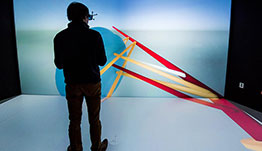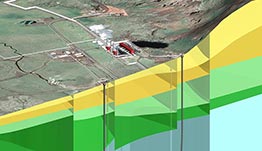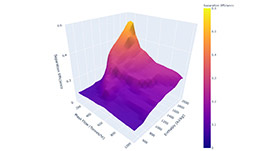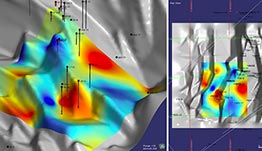Geothermal 2.0
From reducing up-front exploration risk to improving reservoir operations, NREL's Geothermal 2.0 research is focused on next-generation technologies.
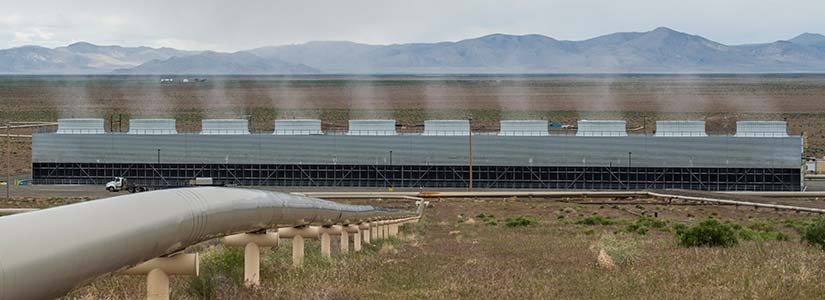
Humans have used geothermal systems for centuries for direct-heat applications such as cooking and heating. The earliest geothermal power plant was developed in 1904 in Lardarello, Italy, and it is still in use today. Geothermal 2.0 builds on this history to develop next-generation innovations.
Improved Well Targeting
Deciding where to drill for geothermal resources to optimize access to the heat beneath the surface is one of the biggest challenges of traditional geothermal development. NREL is working to reduce this risk for developers using advanced machine learning and artificial intelligence.
Play Fairway Analyses
Play fairway analysis (PFA), adapted from the petroleum industry, is a systematic de-risking methodology that integrates quantitative geoscience data to identify prospective geothermal trends for further exploration. The U.S. Department of Energy has funded 11 projects to develop and test geothermal PFA approaches, with five projects ultimately progressing to drilling phase. The projects identified undiscovered geothermal sites and prospective areas for additional analysis and directly informed several federal geothermal lease nominations. NREL is analyzing these projects and developing additional PFA methodologies for geologic settings at a range of scales.
Resource Management
Optimizing geothermal reservoir performance and maximizing energy production over system lifetime requires proper resource management. NREL researchers develop geologic models, dynamic reservoir simulations, and machine learning tools to assist operators and improve resource management.
Supercritical Geothermal Systems
Typical geothermal power production uses modest heat (150°C –250°C) at relatively shallow depths (<3 km). Exploring and producing from deeper, higher-temperature plays—where extremely high-energy, supercritical fluids can be encountered—is higher risk but potentially represents a much greater reward, as the power output from each well can be significantly more. In Iceland, for example, energy output for a single well in these high-enthalpy systems is estimated to be 10 times normal well output. Gaining better insight into higher-energy resource types could significantly improve the economics of geothermal development.
Featured Projects
NREL launched a 2-year project that integrates physics-based modeling and machine learning to improve geothermal reservoir management. NREL researchers are improving subsurface characterization and modeling of fluid movement through geologic lithologies, fractures, and faults using our Eagle supercomputer. This project focuses on two difficult reservoir management decisions: where to drill and complete makeup wells and how to allocate injection into and production from new and existing wells.
Impact
This work closes the gap between annual geothermal generation and installed annual net generation capacity and reduces staff effort and computational time.
Partners
U.S. Geological Survey, Ormat, Heateon, CMG, and QRI
As our PFA projects varied in spatial extent, geologic setting, technical approach, data products, and reporting, NREL was tasked with determining the impact of the projects and comparing their outcomes. Our scientists are evaluating metrics for measuring and valuing exploration knowledge, assessing remaining data gaps in publicly available national exploration knowledge, defining the typical characteristics of geothermal plays, and developing a best practices report for public use throughout the United States and abroad. This project will enhance geothermal exploration practices and the rate of discovery going forward.
Impact
This project will enable us to understand how data reduce exploration risk, increase the discovery rate of geothermal resources by enhancing exploration practices, and support future geothermal PFA programs.
NREL partnered with the New Zealand company Upflow on the Geothermal Operational Optimization with Machine Learning (GOOML) project. The project team is applying machine learning to decades of data from hundreds of wells and multiple power generation facilities—including steam, flash, and binary generators—from New Zealand’s massive Wairakei geothermal field.
The GOOML project is creating “digital twin” system models and applying machine learning analysis of these large operational data sets. Findings from the models will improve operations through optimization of daily processes, scheduling of critical asset maintenance, and prediction and detection of potential trouble events. Geothermal operators can use the technology to achieve a step change in the availability and efficiency of geothermal operations without drilling new wells or constructing new plants. This can reduce the levelized cost of electricity for existing and future geothermal installations and increase the economic competitiveness of geothermal.
Preliminary results demonstrate increases in total power generation ranging from of 2% to 11%.
Impact
Through GOOML, NREL seeks to improve the operational efficiency of geothermal power plant steam fields through the analysis of historical operational data and the development and application of physics-based machine learning algorithms.
Partners
New Zealand Energy Efficiency and Conservation Authority, Upflow New Zealand, Contact, Ngati Tuwharetoa Geothermal Assets, Ormat, FSS
Techno-economic analysis of geothermal systems typically requires assumptions for reservoir and wellbore parameters such as producer-injector well ratio, production temperature drawdown, and production-injection temperature, pressure, and flow rate. To decrease uncertainty of these parameters, NREL analyzed field data from monthly production reports at 19 power plants in California and Nevada covering 196 production wells and 175 injection wells. Read the full report.
Impact
This project resulted in a better understanding of reservoir operations and efficiency for U.S. operations on federal land.
Partners
Bureau of Land Management
NREL is partnering with international research institutions on the Geothermica-funded DEEPEN project to de-risk geothermal exploration in deep, supercritical magmatic plays. The project is developing a play fairway methodology specific to magmatic plays that includes the roots zone of the geothermal system (supercritical fluids, magma bodies, the brittle-ductile transition zone, and other elements). The project is also focused on developing new tools to help with subsurface imaging of deep and hot bodies.
Impact
This project could increase the power output of geothermal plants tenfold, significantly improving geothermal project economics.
Partners
Equinor, Reykjavik Energy, ISOR, NORSAR, Lawrence Berkeley National Laboratory, and other international research institutions
Capabilities
NREL works with industry partners to design and model widespread, cost-effective, and grid-friendly geothermal operations that will lower the cost of geothermal deployment. NREL's geothermal capabilities run the gamut from exploration to operations and from techno-economics to regulations and permitting. Learn more about these Geothermal 2.0 capabilities:
Data and Visualization
Our data resources, data management solutions, and high-quality visualizations advance the use of geothermal energy.
Exploration and Targeting
NREL’s team of geothermal exploration experts has decades of experience in exploring for and identifying resources around the world.
Machine Learning and Artificial Intelligence
We use the latest machine learning techniques, high-performance computing capabilities, and our geothermal expertise to create physics-based tools that solving complex problems.
Subsurface Characterization
We develop novel methodologies and workflows that capture and integrate disparate subsurface data to better define geothermal resources.
These capabilities also support NREL's Geothermal 2.0 activities:
Share

